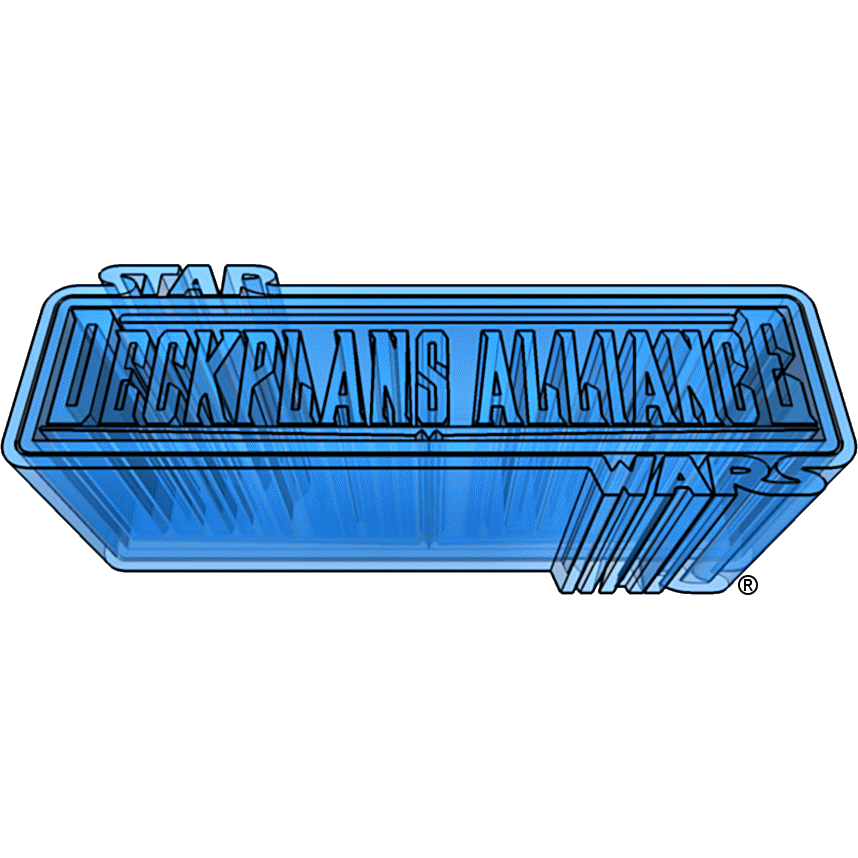
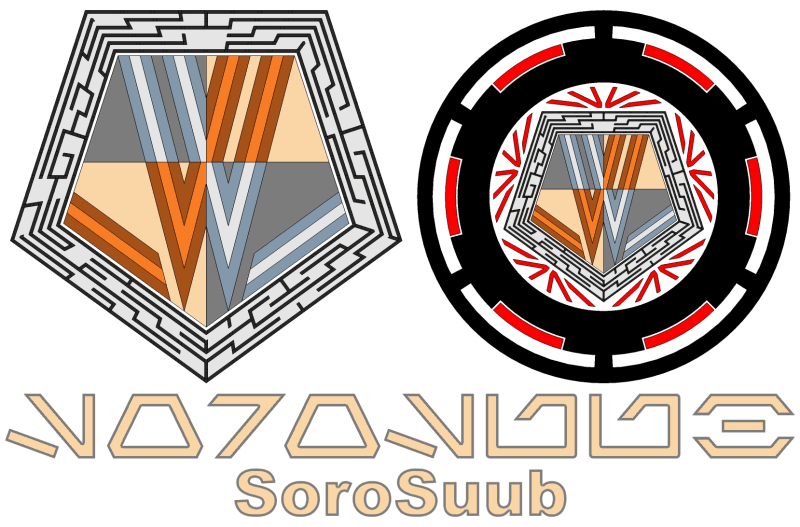
SoroSuub XP-38 Sport Landspeeder
This joint-effort project was developed by Eric "Uncle Servo" Allen, and Frank V Bonura
with help from Lucas P. This project is mainly is based on the original movie production
blueprints from "STAR WARS® - A New Hope", with additional design influences coming
from the artwork of Doug Chiang, and vehicle schematics of Troy vigil in: "STAR WARS®
- The Essential Guide to - Vehicles, and Vessels" by Del Rey® Books.
Behind the scenes:
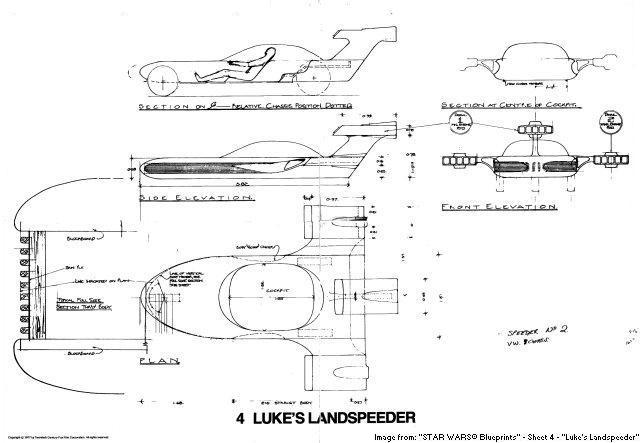
|
The XP-38 presented a challenge from the very beginning due to the fact that very little reference material exists for it; the only reference in the movies to it is when Luke Skywlker complains, “Since the XP-38 came out, they just aren’t in demand.” As brief as this comment is, however, a critical design concept can be determined from it – that the XP-38 has to be similar in overall design to the X-34 (Luke’s speeder) in order to appeal to the same general buyer demographic, yet look different enough to capture the almost undivided attention of that demographic so that nobody would want last year’s model. In other words, the XP-38 had to look somewhat like the X-34 but not very much. Another significant design concept can be found in “STAR WARS® - The Essential Guide To Vehicles & Vessels”, where particular attention is given to SoroSuub’s strategy of marketing the XP-38 to younger buyers who wanted the feel of piloting a starfighter. |
This combined with other information in the "Essential Guide" led us to arrive at the "one part starfighter, one part sports car" design philosophy we adhered to as we began to look at what few images existed. We used three main references in varying degrees for the XP-38: Doug Chiang's and Troy vigil's illustrations from “STAR WARS® - The Essential Guide to Vehicles, and Vessels”, and a not-so-well-known set of blueprints for a full-sized prop that was intended to be shown in “A New Hope” but was never built. These blueprints come from the “STAR WARS® Blueprints” packet sold back in the 70's. The final result incorporates elements from all three sources blending them into one harmonized model. |
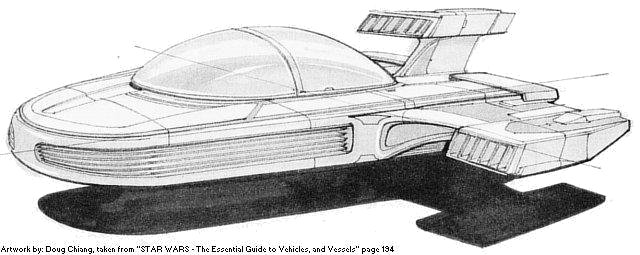
|
The key to the whole design is the canopy. The reason for this is that the illustrators in the Essential Guides all incorporated a closed canopy, yet the roof-line is roughly equal to the top of the windshield on the X-34. This becomes a problem when you realize that Luke and Obi-Wan’s heads rise significantly higher than the top of the windshield. This fact was something the illustrators apparently did not realize. In order to retain the sleek lines in the illustration we were forced to enlarge the size of the speeder to the point where it was almost a full two meters longer than the X-34 prop. We also had to examine how the canopy would actually open. |
After much discussion we decided that the most logical way would be for the front section to slide up and forward much in the same way as our studio model canopy on the A-wing This also helps to reinforce the “one part starfighter, one part sports car” philosophy. As for the rest of the design, the idea was to streamline the body and emphasize the perception of speed even when standing still. The main body is tapered slightly so as to help exaggerate the perspective when viewed from the front, which is further helped along by the slightly pointed nose and tapered side engine. The side profile of the nose is more bullet-shaped than on the X-34 to produce a more streamlined shape. |

|
The interior of the cockpit was also a design challenge, as the only reference is in the Troy Vigil top view. Unfortunately with the re-sizing of the vehicle due to the canopy design we found ourselves with a lot more interior room than in the cramped X-34. We used reference pictures of the X-34 along with references from modern-day sports cars to develop a blended design for the center console, instrumentation cluster, and dashboard accessories. |
Located behind the seats is the cowling that covers the autopilot described by “STAR WARS® -The Essential Guide to Vehicles, and Vessels” as resembling an astromech droid another SoroSuub design element targeting the young would-be starfighter pilot. This structure does not appear in the Chiang drawing, nor in the Vigil schematic, so we decided to correct this, and includ it in our model. |

SoroSuub XP-38 Sport Landspeeder
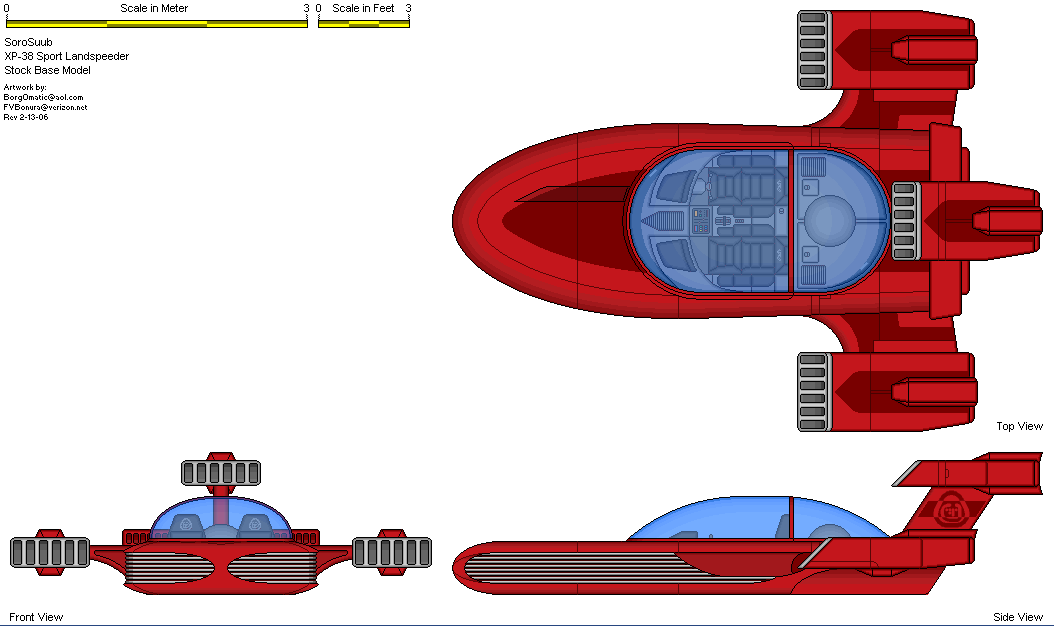
|
Official FIRST EDITION game stats from "The STAR WARS® Sourcebook" First Edtion page 58, written by: Jeffery L. Briggs, and Paul Murphy, Published by: WEST END GAMES®. Landspeeder Craft: SoroSuub XP-38 Landspeeder Ground Vehicle Crew: 1 Passengers: 1 Cargo Capacity: 10 kilograms Speed code: [2D] Maneuverability: [2D] Body Strength: [2D] Weapons: None Flight Ceiling: 2 meters Official SECOND EDITION game stats from the "STAR WARS® Sourcebook" - Second Edition, page 59, written by: Bill Slavicsek, and Curtis Smith, Published by: WEST END GAMES®. Landspeeder Craft: SoroSuub XP-38 Landspeeder Ground Vehicle Type: Landspeeder Scale: Speeder Length: 6.01 meters * Skill: Repulsorlift operation: landspeeder Crew: 1 Crew Skill: Varies dramatically Passengers: 1 Cargo Capacity: 10 kilograms Cover: ½ Altitude Range: Ground level - 2 meters Cost: 10,550 (new), 2,500 (used) Maneuverability: 2D Move: 115; 330 kmh Body Strength: 2D Official game capsule from "The STAR WARS® Sourcebook" First Edtion page 58, written by: Jeffery L. Briggs, and Paul Murphy, and from the "STAR WARS® Sourcebook" Second Edtion page 59, written by: Bill Slavicsek, and Curtis Smith, Both Published by WEST END GRAMES®. Capsule: The XP-38 landspeeder, the most advanced and hottest-selling craft of its kind on the market, can reach velocities of 320 kilometers per hour, has a cruising ceiling of two meters, and has an optional sensor package available. The autopilot is built into the rear of the craft and is shaped like Industrial Automaton's popular R2 astromech droid. This, along with the low reclining seat and advanced control board, according to the advertisements, "gives you the feel of flying a starfighter." Erata Notes: * The "official" stat for: "Length: 7.4 meters" was determined by the team to be too long for the scaled 1.8 meter tall driver we used to size the model to provide a "snug fit". The team has determined the correct length to be 6.01 meters, or 591 pixels in "Yellowscale." |
Official capsule from “STAR WARS® -The Essential Guide to Vehicles, and Vessels” page 194, written by: Bill Smith, Published by by Del Rey® Books. SOROSUUB XP-38 SPORT LANDSPEEDER The XP-38 landspeeder, Which is manufactured by the Sullustan company SoroSuub, is a popular landspeeder that can attain a top speed at over three hundred kilometers per hour. While they had been out for only a few months when Luke Skywalker left Tatooine, they had already become immensely popular even on that backwater desert planet. The XP-38's popularity decreased demand for older speeders, as Luke Skywalker discovered when he tried to sell his battered SoroSuub X-34 at a used speeder lot in Mos Eisley. The XP-38 is a model that emphasizes smooth lines and sheer speed over practicality. As It has room for only a driver and passenger, it has been clearly aimed at the recreational market. Advertising has targeted younger customers, who often show a preference for style over value or durability. The driver and passenger share a snug cockpit that features a retractable duraplex windscreen which opens to allow passengers to board. The optional sensor array is mounted on a swivel so that either the driver or the passenger can run the system, while displays con be viewed on the vidscreen or presented holographically. There is a small cargo comportment hidden behind the seats. The XP-38 has a rear-mounted autopilot under the cowling, behind the pilot. The autopilot appears to be an Industrial Automaton R2 astromech droid, but this is a purely cosmetic effort designed to appeal to youngsters who seek the illusion that they are piloting a starfighter. As with standard landspeeders, a repulsorlift generator produces lift and provides power to the turbine engines. The XP-38 sports a trio of rear-mounted turbine engines as well as twin maneuvering flaps and exhaust nacelles on the rear deck. The XP-38 has tight cornering ability and fantastic acceleration making it a prize choice for those who engage in "neighborhood racing” against friends. It has a maximum hovering height of two meters, but drivers tend to set the speeder to hover at about one meter above the ground, following standard landspeeder repulsor altitudes. Engine noise is excessive, particularly by modern speeder standards, but that was considered a positive selling point with the target audience. For all the hoopla about its performance, the XP-38 pulls many design features from earlier SoroSuub models such as the XP-38A and the Tx-37. A particular weakness it inherited is a very stiff repulsor generator setting. It's geared for performance but isn't durable enough for rough terrain, so the XP-38 is limited to extremely smooth surfaces. While the suspension can be recalibrated for rougher terrain, this can take up to three hours at a time. The control computer never seems to be able to properly reset suspension rates, either, so most owners just don't bother with the repulsor system. Game Notes: Optional rule - Stiff Suspension: For those who wish to use the story elements of the “Essential Guide” in their campaign, the following optional rule can be used to simulate the “stiff repulsor generator setting” of the XP-38.When the XP-38 is used in rough terain (terrain difficulty of moderate or worse), its maneuverability rating is reduced to 1D. Any movement failures should be taken into consideration normally, and then in addition, roll damage for “bottoming-out” the speeder. When the speeder “bottoms-out”, it strikes the ground or an obstacle under it. “Bottoming-out” should be treated as a “sideswipe” in the movement failure collision rules. Thus the speeder should take -3D damage from its normal collision damage based on its speed. |
Return to Main Menu